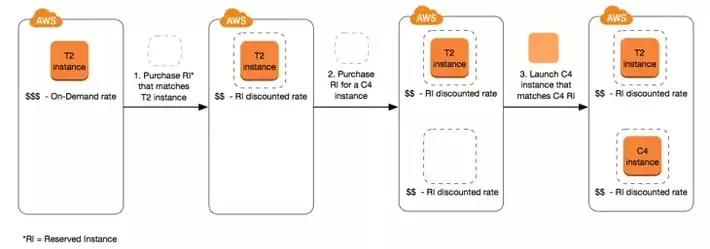With 240 distinct services, ranging from compute to storage to networking and content delivery — each offered at different price points — choosing the right AWS service requires meticulous consideration..
By default, AWS services are available on-demand and you pay a monthly bill for services used. However, the on-demand pricing model can get expensive if you use a lot of services and deploy a fleet of instances.
Fortunately, AWS offers ways for businesses to save on their cloud spend — with purchasing options like Reserved Instances and Savings Plans. Each of these options has its pros and cons, so ensure you weigh them before making the purchase decision.
In this post, we’ll explain what AWS reserved instances are and how you can make the most of them for your business.
What Is A Reserved Instance In AWS?
An AWS reserved instance is a “billing discount” that applies to the usage of an On-Demand instance in your account when you commit to use a specific instance type for one or three years. So, a reserved instance is not actually a physical instance or virtual machine.
Reserved instances are ideal for steady and predictable usage. They can help you save significantly (up to 72%) on your Amazon EC2 usage costs compared to On-Demand instance pricing. The discount applies to the type of instance you pick.
On-Demand Vs. Reserved Instances: What’s The Difference?
“The only difference between reserved and on-demand instances is in the billing,” says Veronica Miller, cybersecurity expert at VPNoverview. Miller explains that a reserved instance is rented for a definite period of time at a lower rate (per-hour or per-second) than basic AWS on-demand instances.
Reserved instances and on-demand instances have the same compute options and configurations.
“All you’re doing is committing to use in return for a lower hourly rate, which AWS will apply to your bill after the month ends, depending on the instances that best fit your workload,” explains Miller.
How Do AWS Reserved Instances Work?
Reserved instances are applied to matching on-demand instances running in your AWS account. The determining instance attributes are:
- Instance type – a combination of the instance family (e.g., m4) and size (e.g., large, xlarge, etc.)
- Region – the region in which the instance is purchased
- Tenancy – the type of hardware on which your instance runs (single or shared)
- Platform – the operating system (Windows or Linux/Unix)
For the discounted rate to apply, the on-demand instance must have matching attributes with the reserved instance.
Below is an official diagram from AWS that explains the process.

In the diagram above, when the customer purchases a reserved instance that matches the running instance of t2, the discounted rate is applied immediately (boxes one and two).
But when the customer purchases a c4 reserved instance, the discounted rate is not used since there are no matching on-demand c4 instances on the account and the discount cannot be applied to the existing t2 instance (box three). The discount is only applied when the customer purchases a matching c4 instance (box four).
Here’s a practical example:
Suppose the following instances are running in your account:
- m3.large Linux, default tenancy instance in availability zone us-east-1a
- c4.xlarge Amazon Linux, default tenancy instances in availability zone us-east-1c
If you purchase an m3.large Linux, default tenancy reserved instance in us-east-1a, the discount applies to the first instance in your account which has the matching attributes ( instance type–m3.large, region–us-east-1c, tenancy–default, and platform–Linux).
However, if you purchase a c4.large Linux, default tenancy reserved instance in us-east-1a, it will not apply to the second instance because the attributes do not match.
How Much Does A Reserved Instance Cost?
Since reserved instances are basically discounts applied to on-demand instances, their prices are tied to the base price of the on-demand instance.
However, four key variables determine the cost of a reserved instance:
- Instance attributes
- Term commitment
- Payment options
- Offering class
These variables determine the amount of savings you can expect with a reserved instance compared to the on-demand pricing.
Instance attributes
As already mentioned in the preceding section, four instance attributes (instance type, region, tenancy, and platform) determine if a discount is applied.
Term commitment
Two commitment terms are available for reserved instances:
- One year, defined as 3,1536,000 seconds (365 days)
- Three years, defined as 94,608,000 seconds (1,095 days)
The longer term attracts higher discounts.
Payment options
The payment option selected also affects the discount percentage. Three payment options are available for AWS reserved instances:
- All Upfront (where full payment is made at the beginning of the term)
- Partial Upfront
- No Upfront
You receive better savings when you pay more upfront. If you choose partial or no upfront payment, the cost of the reserved instance will be charged monthly.
Offering class
Your computing needs might change after you purchase a reserved instance. AWS offering classes make it possible to modify or exchange your reserved instances. The classes are:
Standard Instances
You receive the highest savings with standard instances, but they cannot be exchanged. They can only be modified. Standard reserved instances bind you to one instance family on the same operating system. This instance class is recommended for reliable workloads and maximum savings.
Convertible Instances
Discounts are lower for convertible instances compared to standard instances. However, they can be exchanged or modified. Convertible reserved instances provide the flexibility to change families, operating systems, and tenancies, but at a lower discount.
All these variables are considered in the pricing of reserved instances. The table below shows the pricing for an a1.medium Linux instance in the US East (Ohio) region. The All Upfront payment option offers the most savings compared to other payment options.

Below is the pricing of the convertible version of the instance for the same one-year term.

The cost savings decrease considerably compared to the standard reserved instance for a one-year term. When the commitment term is increased to three years, savings jump up to 62% for the All Upfront payment plan.

Percentage cost savings for an a1.medium Linux instance in the US East (Ohio) region:
One-Year Term | Three-Year Term | |||
| Payment Option |
Standard |
Convertible |
Standard |
Convertible |
| No Upfront |
37% |
27% |
57% |
50% |
| Partial Upfront |
40% |
31% |
60% |
54% |
| All Upfront |
41% |
32% |
62% |
55% |
What Are The Benefits Of Using AWS Reserved Instances?
One of the main advantages of Reserved instances is the significant amount of savings you get. But there’s more.
- RIs can be up to 72% cheaper compared to On-Demand instance pricing.
- AWS RIs provide predictable compute power and costs over a year or three. This makes RIs ideal for workloads with predictable, consistent computing requirements.
- You can exchange a Convertible RI for another one with a different configuration, such as a different instance family, operating system (OS), or tenancy. But you cannot sell Convertible RIs in the Reserved Instances Marketplace.
- With Standard RIs you can tweak the instance size (within the same instance type), Availability Zone (AZ), scope, and networking type of your AWS Reserved Instance. You can also sell Standard RIs in the RIs Marketplace.
- Standard RI offers up to 3X more discount compared to Convertible RIs. Convertible RIs, however, allow for greater flexibility should your computing needs change during your contract period.
Nevertheless, there are a few important limitations to keep in mind.
The Limitations Of AWS Reserved Instances
Before committing long-term to AWS RIs, take a closer look at the following cons.
1. You can’t cancel a reserved instance.
This is a key point to consider because when you purchase a reserved instance, you agree to pay for the service whether you use it or not.
This means you must be absolutely sure that your business needs the reserved instance. Velez Vasquez, CEO of Home Security, recommends buying reserved instances only if you’ll be using it nearly 24 hours a day, seven days a week (or at least more than 75 percent of the time).
While deploying the right reserved instance for your business can help you save significant costs, the wrong instance could easily become a financial suck. The only way to get rid of an unwanted reserve instance is to trade it on the Reserved Instances Marketplace.
Keep in mind that there are requirements that must be met before you can sell your instance. So, consider the additional work required to sell a reserved instance before you make a commitment.
2. You must commit to either 1 or 3 years.
The commitment term for AWS reserved instances is one year or three years. Even if you choose to make no payments upfront, you will still make monthly payments for the instance regardless of usage.
In fact, you will be billed for this amount whether you ran an instance that matched your reservation or not. That is, your discount may not be applied to any in-demand instance but you will still pay for the reserved instance.
When Should You Use Reserved Instances?
“If you need always-on compute power, say for an application under constant usage, and that application will be running for at least a year, reserved instances are a much better option than on-demand because you will save a huge amount,” explains Nelson Ford, founder and principal solutions architect at Pilotcore, an AWS consulting company.
Ford explains that if your application can run at any time, and it doesn’t matter if it stops occasionally or runs at odd hours, then spot instances might be a better option.
It’s also possible to configure a fleet that uses a combination of on-demand, spot, and reserved instances.
If you’re not sure which instance type is best for your performance needs, then Vasquez recommends starting with any on-demand instance for a month or two and then experimenting with different instance types.
The aim is to find the least costly instance type that meets your performance requirements. “Buy reserved instances only if you’ll be using it nearly 24 hours a day, seven days a week (or at least more than 75 percent of the time),” says Vasquez.
Keep in mind that AWS reserved instances are not the only option for saving costs in AWS. AWS Savings Plans may be a better option depending on your business needs. The key difference is that while you receive a discount for committed usage with AWS reserved instances, the discount is applied for committed spend in a savings plan. However, the discount rates are similar — both saving up to 72%.
See our posts on how to choose an AWS savings plan and the benefits/limitations of savings plans for more information.
And if you think savings plans or reserved instances are the only things you can do to keep your AWS bill low, this video breaks down all the reasons cloud bills run higher than expected — and some proven ways to keep them in check:
Make Smarter Cloud Cost Management Decisions With Cloud Cost Intelligence
Clearly, AWS reserved instances can help your business save significant costs, but they can become a financial drain if you make the wrong decision.
Reducing your AWS cloud bill is not just about using a savings plan or reserved instances — it’s also about understanding your cloud costs beyond your absolute cloud bill so you can make smarter decisions about your cloud consumption, prevent waste and optimize costs.
Businesses struggle when trying to make a decision about reserved instances because they do not have clear visibility into their cloud costs. They may have an idea of their absolute cloud bill, but no visibility into how individual features, products or teams contribute to that cloud cost.
Without that level of visibility, your business is only making guesses about your cloud spend. CloudZero provides the context that’s needed to understand your cloud bill, by connecting your cloud costs to key business metrics such as cost per customer or product feature.
In addition, CloudZero’s anomaly detection feature allows you to monitor your AWS instances for unusual cost spikes. When an abnormal spike is detected, CloudZero immediately alerts the responsible team in Slack so they can take action right away. This helps control your cloud costs and prevent unexpected surges in your AWS bill.
Validity now spends 90% less time managing cloud costs. And Drift has saved over $4 million in cloud costs.
 to see how CloudZero can help you reduce your cloud bill and keep your costs under control.
to see how CloudZero can help you reduce your cloud bill and keep your costs under control.
Frequently Asked Questions About AWS Reserved Instances
What is the difference between an On-Demand instance and Reserved Instance?
With an AWS RI, you commit to using a specific instance type and AWS Region for a set period of time whereas with an On-Demand instance, there are no long-term commitments or payment options. On-Demand pricing is up to 72% more expensive than the RI commitment. But On-Demand instances also provide users with the flexibility to increase or decrease their usage at any time.
What is the difference between Reserved Instances and Savings Plans?
Reserved instances require you to use a specific instance family in a specified AWS Region for a fixed one or three-year period. Meanwhile AWS Savings Plans require you to commit to spending a certain dollar amount per hour for a one or three year period.
What is a Standard Reserved Instance in AWS?
Standard RIs offer higher discounts for committing to use a specific instance family and operating system within a specified Region. But Standard RIs can be sold in the RIs Marketplace.
What is a Convertible Reserved Instance in AWS?
Convertible RIs offer lower discounts but more flexibility, enabling you to modify your instance family, operating system, and tenancy. That flexibility also means you can’t sell Convertible RIs in the RIs Marketplace.
What are the 3 types of reserved instances pricing available from AWS?
AWS offers all upfront, partial upfront, and no upfront payment options for RIs.








